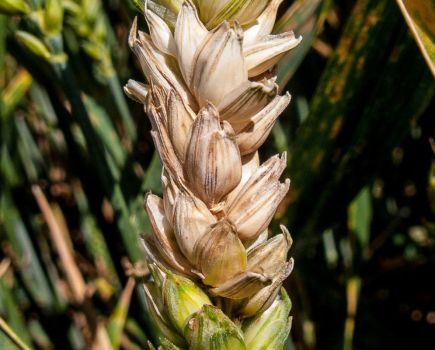With an exceptionally slow and difficult start to the season for farmers across the country, CPM seeks advice from the experts on how to address some of the biggest spraying challenges on the horizon and how to make every spray as effective as possible this spring.
“It’s crucial growers find ways to gain efficacy so crops have more of a fighting chance.”
By Charlotte Cunningham
Sprayer operators and farm managers are used to dealing with the vagaries of the weather, but with record-breaking extremes leading to unprecedented delays and workload pressures, there’s a lot riding on the next few months to safeguard remaining yield potential.
This is according to Stuart Sutherland, technical manager at Interagro who says that with sprays already behind schedule, and weeds and pests off to a head start, there’s no room for error this spring. “It’s crucial growers find ways to gain efficacy so that crops have more of a fighting chance, especially where salvaging winter crops which have already suffered.”
Stuart believes that this is where the right adjuvant will make all the difference. “By definition, adjuvants are products which are designed to be used with plant protection products to enhance their effectiveness. With a lot of pressure on these plant protection products over the coming weeks, teaming them with an adjuvant could help to push their performance.”
When it comes to specific products, Stuart says that something like Interagro’s Kantor ticks the box well when it comes to the five biggest questions facing spray operators right now.
- What’s the best way to avoid a tank mixing disaster?
Tank mixing chemicals gives flexibility, saves time, and may increase pesticide effectiveness, but it can also be a sprayer operator’s worst nightmare when things go wrong.
And with spray jobs stacking up and multiple mixes on the cards this spring — combined with cool conditions — it’s a potential recipe for disaster, says Stuart. So, how can this be avoided without multiple passes?
The first step is to start with a scrupulously clean sprayer, even if it’s been sat in the shed during winter,explains Stuart. “It’s really important to flush the tank and lines before kicking off the season, just in case there’s any unwanted residues from previous mixes that could impact the mixing process.
“When you’re ready to begin, it’s important to half fill the spray tank with clean water before adding any products and be sure to maintain good agitation throughout the filling operation.”
Formulation of products also plays a part in how well they mix, he adds. “Wettable powders, emulsifiable concentrates and salt formulations are all tricky formulations. It’s crucial to use the correct mixing order for formulation types and always read product labels and follow the guidance.
“This spring, mixing conditions could be particularly tricky with lots of different products being incorporated together at T0 and T1 – a herbicide, PGR, maybe micronutrients, biostimulants, a fungicide etc.
“There could be a good 5-6 products going into the tank, which could easily mean at least 7-8 active ingredients trying to mix. That’s not to mention the cold water which slows the process. If you’ve ever forgotten to boil the kettle and then poured cold water into your mug of coffee granules, you’ll have noticed it just doesn’t mix properly.”
Variability in water temperature and quality also both affect how well products dissolve into it, continues Stuart. “Low water volume spraying, high pH, hard water, all make the mixing process more challenging.”
Given the risks this season in particular, adding compatibility adjuvant Kantor to the water before adding inputs is highly recommended to help avoid any problems, he says. “There’s plenty of typical adjuvant benefits to Kantor, but there’s also a lot of unique benefits to it and tank mix compatibility is one of them.”
Extensive testing over the years has shown that adding Kantor to the spray tank, before adding chemicals, speeds up the mixing process and helps traditionally incompatible mixtures to blend together. “What’s more, Kantor helps speed up the process in cold water and will keep products in suspension,” adds Stuart. “It also contains a pH buffer to protect active ingredients from breakdown if spray water is on the alkaline side.”
With micronutrients mixes particularly notorious for being tricky, Stuart says that trials have often used them to highlight the compatibility benefits of Kantor. “In a recent study at Eurofins, a widely used potassium and magnesium micronutrient was used to demonstrate the difficult nature of mixing in cold water. Within 10 minutes, some of the active ingredient had settled out and was sat at the bottom of the mixing tube.
“After 30 minutes, even more of the active ingredient was sat at the bottom – it was really visible. Of course, in the field, growers wouldn’t even realise product could be settling out in the tank until they get a blocked nozzle. They could be losing valuable nutrition and efficacy without evening realising it.
“With the season the way it is, fast and efficient mixing will be key to minimising downtime. Kantor’s unique adjuvant properties promote emulsification, enabling complex tank mixing in a single pass, making it a crucial addition.”
In terms of how to incorporate it into the tank, Stuart says it’s a very simple process. “Once you’ve half-filled the sprayer with water, simply add Kantor at a rate of 0.15% of the intended spray volume.
“Then you can start adding your crop inputs one by one;add more water as products are added. Make sure concentrates don’t come into contact with each other in the induction bowl,” warns Stuart.
“Allow one product to completely clear the induction bowl before adding the next one and check slow to dissolve formulations like wettable powders and water dispersible granules are in solution before adding more.
“Only mix up what’s required – never leave a mixed solution in the spray tank overnight — and clean the sprayer thoroughly between jobs. In a busy spring it may be tempting to take shortcuts, but it will just cause more pain in the long run.”
- Is it possible to recover a problematic tank mix?
Although every precaution should be taken to avoid a tank mixing issue, with time and effort it may be possible to recover a problematic tank mix using Kantor, says Stuart.
“In 2023, another challenging spraying season for growers, the tank mix recovery benefits of Kantor were fully utilised on numerous farms.
“On one such farm, a complex seven-way tank-mix application to asparagus proved problematic for Evesham Vale Growers spray operations manager, Will Parrott. Settling and sediment in the spray tank was leaving sprayer nozzles almost completely blocked. But by adding Kantor, Will was able to recover his mix and apply to the crop with no further issues.”
- Can high pH water be prevented from depleting crop protection efficacy?
Water may be an essential carrier for pesticide applications, but it can also destroy the active ingredients in crop protection products if its pH is too high, says Stuart. “Many active ingredients undergo a chemical reaction known as alkaline hydrolysis in water. The more alkaline the water, the faster the breakdown, reducing absorption into plants. Hydrolysis can be very fast when pH of the water is greater than pH 8/9.
“These inputs come at significant cost. Growers could lose valuable efficacy, so it’s vital they understand the products which are at risk. I’d advise they take any necessary steps to test their spraying water and correct quality ahead of filling sprayers to maximise pesticide performance.”
So which products are at risk, and how can it be avoided?
The summary table shows some of the most commonly used products at risk – these include carbamates and pyrethroids, some PGRs and fungicides, and some herbicides, including glyphosate.
Glyphosate for example, is most stable at pH 5 and therefore most water will require treatment with a suitable water conditioner to buffer or acidify the water before glyphosate is added to the spray tank, notes Stuart.
In terms of avoiding water being a hurdle, checking the pH prior to spraying is vital, he adds. “The easiest method to check the pH of your spray water is with pH test paper or a pH meter.
“If the pH of your spray water is too high, you should lower it to pH 6-7 which is the most stable pH for most of the crop protection products you’ll be applying.
“Harvesting rainwater is a great, low-cost way to achieve good spraying water with a slightly acidic pH – it will be suitable for most of the inputs you will be applying to crops.”
Alternatively, if the pH is too high, growers can lower it using a water conditioner to acidify or buffer pH, which will also isolate any problematic hard water cations if present. Or they can use an adjuvant with pH buffering properties, such as Kantor, says Stuart.
“As alkaline water can reduce performance so significantly, adding a water conditioner or buffering adjuvant as standard is a good idea. This way you can be certain your spray mixture is stable and uptake into plants can be maximised. It’s also a low-cost way of gaining efficacy and when growers are spending out so much on inputs, it makes sense to get the most out of them.”
- Is it possible to gain more spraying hours?
With spray windows likely to be tight over the coming weeks, and spray jobs behind schedule, efficiency will be the name of the game, states Stuart. And though there’s no way to freeze time, there are a few quick wins to help sprayer operators gain more spraying hours.
The two main ones are improving rainfastness and reducing drift, he explains. “Both have the potential to stop spraying, so if you can alleviate that without compromising efficacy, it’s a sure way to gain extra spraying hours.
“This could actually become crucial regarding fungicide timings, especially in forward wheat crops as temperatures start to build, and if we have a catchy showery spring with conditions conducive to septoria,” he says.
The improved rainfastness and drift reduction properties of Kantor can help both extend these windows and keep crop protection where it needs to be for longer. “Kantor enables more precise and targeted applications by significantly reducing the number of <100 micron fine spray droplets which are most susceptible to drift,” he explains. “Crucially, this reduces the risk of off-target damage and environmental contamination, while also providing flexibility in scheduling crop protection applications.”
- How can contact herbicide and protectant fungicide efficacy be maximised?
Stuart says it’s likely growers will see bigger weeds than usual this season, with a flush no doubt imminent when temperatures do warm up. Maximising fungicide coverage to target leaf layers will also be crucial, particularly as most fungicides have little curative activity these days, he adds.
So how can coverage be optimised to maximise efficacy?
“Coverage comes down to application technique. It’s always a challenge, but when sprays are delayed and plant targets are larger, then coverage can be more problematic,” says Stuart. “Generally, weed control becomes trickier as the season develops. You have shading from the crop to think about and waxier leaves which reduces the spreading ability of the herbicide and its uptake. Field conditions aren’t great either at the moment, so achieving good coverage could be harder than usual.
“The addition of Kantor will help to create a more optimal droplet size to improve deposition and adhesion to plant surfaces by reducing the number of coarse droplets, he adds. “What’s more, Kantor’s ability to reduce surface tension and promote spreading results in better coverage of target plants and leaf layers, leading to more effective treatment overall.”
While the coming weeks are likely to be challenging, leaning on the benefits of an adjuvant could help to alleviate some of the pressure, concludes Stuart. “They’re not a silver bullet, and while care should always be taken to ensure mixes are compatible and best practice is followed, Kantor could be a farmer’s best friend in what is likely to be a challenging few months.
“It’s the only adjuvant on the market that really alleviates the biggest issues sprayer operators are up against this spring.”
This article was taken from the latest issue of CPM. Read the article in full here.
For more articles like this, subscribe here.
Sign up for Crop Production Magazine’s FREE e-newsletter here.




